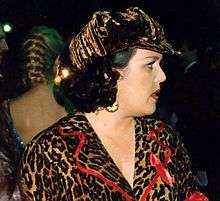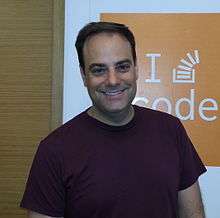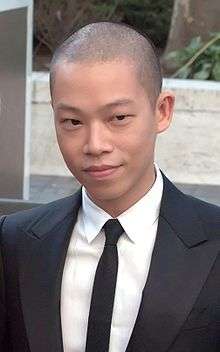LGBT culture in New York City
| LGBT culture in New York City | |
|
The Stonewall Inn in the gay village of Greenwich Village, Manhattan, the cradle of the modern gay rights movement.[1][2][3] |
| Part of a series on |
| Lesbian, gay, bisexual, and transgender (LGBT) people |
|---|
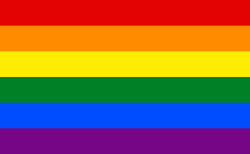 |
| Sexual orientation |
| History |
| Culture |
| Rights |
| Social attitudes |
| Prejudice / Violence |
|
Academic fields and discourse |
|
|
New York City has one of the largest and most prominent LGBT populations in the world. Brian Silverman, the author of Frommer's New York City from $90 a Day, wrote the city has "one of the world's largest, loudest, and most powerful" LGBT communities" and "Gay and lesbian culture is as much a part of New York's basic identity as yellow cabs, high-rises, and Broadway theater."[4] LGBT Americans in New York City constitute by significant margins the largest self-identifying lesbian, gay, bisexual and transgender communities in the United States, and the 1969 Stonewall Riots in Greenwich Village are widely considered to be the genesis of the modern gay rights movement.[1] As of 2005, New York City was home to an estimated 272,493 self-identifying gay and bisexual individuals.[5] The New York City metropolitan area had an estimated 568,903 self-identifying GLB residents.[5] Meanwhile, New York City is also home to the largest transgender population in the United States, estimated at 25,000 in 2016.[6]
History
Charles Kaiser, author of The Gay Metropolis: The Landmark History of Gay Life in America, wrote that in the era after World War II, "New York City became the literal gay metropolis for hundreds of thousands of immigrants from within and without the United States: the place they chose to learn how to live openly, honestly and without shame."[7]
Stonewall Inn
The Stonewall Inn, located at 51 and 53 Christopher Street, along with several other establishments in the city, was owned by the Genovese crime family.[8] In 1966, three members of the Mafia invested $3,500 to turn the Stonewall Inn into a gay bar, after it had been a restaurant and a nightclub for heterosexuals. Once a week a police officer would collect envelopes of cash as a payoff; the Stonewall Inn had no liquor license.[9][10] It had no running water behind the bar—used glasses were run through tubs of water and immediately reused.[11] There were no fire exits, and the toilets overran consistently.[12] Though the bar was not used for prostitution, drug sales and other "cash transactions" took place. It was the only bar for gay men in New York City where dancing was allowed;[13] dancing was its main draw since its re-opening as a gay club.[14]
Visitors to the Stonewall Inn in 1969 were greeted by a bouncer who inspected them through a peephole in the door. The legal drinking age was 18, and to avoid unwittingly letting in undercover police (who were called "Lily Law", "Alice Blue Gown", or "Betty Badge"[15]), visitors would have to be known by the doorman, or look gay. The entrance fee on weekends was $3, for which the customer received two tickets that could be exchanged for two drinks. Patrons were required to sign their names in a book to prove that the bar was a private "bottle club", but rarely signed their real names. There were two dance floors in the Stonewall; the interior was painted black, making it very dark inside, with pulsing gel lights or black lights. If police were spotted, regular white lights were turned on, signaling that everyone should stop dancing or touching.[15] In the rear of the bar was a smaller room frequented by "queens"; it was one of two bars where effeminate men who wore makeup and teased their hair (though dressed in men's clothing) could go.[16] Only a few transvestites, or men in full drag, were allowed in by the bouncers. The customers were "98 percent male" but a few lesbians sometimes came to the bar. Younger homeless adolescent males, who slept in nearby Christopher Park, would often try to get in so customers would buy them drinks.[17] The age of the clientele ranged between the upper teens and early thirties, and the racial mix was evenly distributed among white, black, and Hispanic patrons.[16][18] Because of its even mix of people, its location, and the attraction of dancing, the Stonewall Inn was known by many as "the gay bar in the city".[19]

Police raids on gay bars were frequent, occurring on average once a month for each bar. Many bars kept extra liquor in a secret panel behind the bar, or in a car down the block, to facilitate resuming business as quickly as possible if alcohol was seized.[8] Bar management usually knew about raids beforehand due to police tip-offs, and raids occurred early enough in the evening that business could commence after the police had finished.[20] During a typical raid, the lights were turned on, and customers were lined up and their identification cards checked. Those without identification or dressed in full drag were arrested; others were allowed to leave. Some of the men, including those in drag, used their draft cards as identification. Women were required to wear three pieces of feminine clothing, and would be arrested if found not wearing them. Employees and management of the bars were also typically arrested.[20] The period immediately before June 28, 1969, was marked by frequent raids of local bars—including a raid at the Stonewall Inn on the Tuesday before the riots[21]—and the closing of the Checkerboard, the Tele-Star, and two other clubs in Greenwich Village.[22]
On June 23, 2015, the Stonewall Inn was the first landmark in New York City to be recognized by the New York City Landmarks Preservation Commission on the basis of its status in LGBT history,[23] and on June 24, 2016, the Stonewall National Monument was named the first U.S. National Monument dedicated to the LGBTQ-rights movement.[1]
Stonewall Riots
Police raid

At 1:20 a.m. on Saturday, June 28, 1969, four plainclothes policemen in dark suits, two patrol officers in uniform, and Detective Charles Smythe and Deputy Inspector Seymour Pine arrived at the Stonewall Inn's double doors and announced "Police! We're taking the place!"[25] Stonewall employees do not recall being tipped off that a raid was to occur that night, as was the custom. According to Duberman (p. 194), there was a rumor that one might happen, but since it was much later than raids generally took place, Stonewall management thought the tip was inaccurate. Days after the raid, one of the bar owners complained that the tipoff had never come, and that the raid was ordered by the Bureau of Alcohol, Tobacco, and Firearms, who objected that there were no stamps on the liquor bottles, indicating the alcohol was bootlegged.
Historian David Carter presents information[26] indicating that the Mafia owners of the Stonewall and the manager were blackmailing wealthier customers, particularly those who worked in the Financial District. They appeared to be making more money from extortion than they were from liquor sales in the bar. Carter deduces that when the police were unable to receive kickbacks from blackmail and the theft of negotiable bonds (facilitated by pressuring gay Wall Street customers), they decided to close the Stonewall Inn permanently. Two undercover policewomen and two undercover policemen had entered the bar earlier that evening to gather visual evidence, as the Public Morals Squad waited outside for the signal. Once inside, they called for backup from the Sixth Precinct using the bar's pay telephone. The music was turned off and the main lights were turned on. Approximately 205 people were in the bar that night. Patrons who had never experienced a police raid were confused. A few who realized what was happening began to run for doors and windows in the bathrooms, but police barred the doors. Michael Fader remembered,
"Things happened so fast you kind of got caught not knowing. All of a sudden there were police there and we were told to all get in lines and to have our identification ready to be led out of the bar."
The raid did not go as planned. Standard procedure was to line up the patrons, check their identification, and have female police officers take customers dressed as women to the bathroom to verify their gender, upon which any men dressed as women would be arrested. Those dressed as women that night refused to go with the officers. Men in line began to refuse to produce their identification. The police decided to take everyone present to the police station, after separating those cross-dressing in a room in the back of the bar. Maria Ritter, then known as Steve to her family, recalled, "My biggest fear was that I would get arrested. My second biggest fear was that my picture would be in a newspaper or on a television report in my mother's dress!"[27] Both patrons and police recalled that a sense of discomfort spread very quickly, spurred by police who began to assault some of the lesbians by "feeling some of them up inappropriately" while frisking them.[28]
Transgender contribution
The transgender community in New York City played a significant role in fighting for LGBT equality during the period of the Stonewall Riots and thereafter.[29] However, until the Stonewall riots, this community had felt marginalized and neglected by the gay community.[29] Over the next several decades and especially since the inception of the 21st century, New York City's transgender community has grown in size and prominence,[30] reaching an estimated 25,000 in 2016.[6]
Demographics and economy
Population and concentration
| Geographic entity | GLB population | Density of GLB individuals per square mile | Percentage of GLB individuals in population |
|---|---|---|---|
| New York City | 272,493 | 894 | 4.5 (2005) |
| New York City metropolitan area | 568,903 | 84.7 | 4.0 |
Economic clout
Lonely Planet New York City stated that of the demographics, the city's LGBT population has "one of the largest disposable incomes",[31] encompassing professionals including physicians, attorneys, engineers, scientists, financiers, and journalists, as well as those in the entertainment industry and in fashion design. Conversely, New York City is also a highly popular LGBT tourist destination,[32] and the city actively courts LGBTQ tourism.[33]
Gay villages
Manhattan
Chelsea in Manhattan has become a focal point of gay socialization. The Christopher Street area of the West Village portion of Greenwich Village in Manhattan was the historical hub of gay life in New York City and continues to be a cultural center for the LGBT experience. The East Village/Lower East Side area of Manhattan is also a gayborhood. Hell's Kitchen and Morningside Heights are additional Manhattan neighborhoods which have developed a significant LGBT presence of their own.[32]
Greenwich Village
.jpg)
The Manhattan neighborhoods of Greenwich Village and Harlem were home to a sizable homosexual population after World War I, when men and women who had served in the military took advantage of the opportunity to settle in larger cities. The enclaves of gays and lesbians, described by a newspaper story as "short-haired women and long-haired men", developed a distinct subculture through the following two decades.[34] Prohibition inadvertently benefited gay establishments, as drinking alcohol was pushed underground along with other behaviors considered immoral. New York City passed laws against homosexuality in public and private businesses, but because alcohol was in high demand, speakeasies and impromptu drinking establishments were so numerous and temporary that authorities were unable to police them all.[35]
The social repression of the 1950s resulted in a cultural revolution in Greenwich Village. A cohort of poets, later named the Beat poets, wrote about the evils of the social organization at the time, glorifying anarchy, drugs, and hedonistic pleasures over unquestioning social compliance, consumerism, and closed mindedness. Of them, Allen Ginsberg and William S. Burroughs—both Greenwich Village residents—also wrote bluntly and honestly about homosexuality. Their writings attracted sympathetic liberal-minded people, as well as homosexuals looking for a community.[36]
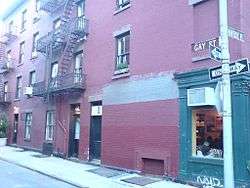
By the early 1960s, a campaign to rid New York City of gay bars was in full effect by order of Mayor Robert F. Wagner, Jr., who was concerned about the image of the city in preparation for the 1964 World's Fair. The city revoked the liquor licenses of the bars, and undercover police officers worked to entrap as many homosexual men as possible.[37] Entrapment usually consisted of an undercover officer who found a man in a bar or public park, engaged him in conversation; if the conversation headed toward the possibility that they might leave together—or the officer bought the man a drink—he was arrested for solicitation. One story in the New York Post described an arrest in a gym locker room, where the officer grabbed his crotch, moaning, and a man who asked him if he was all right was arrested.[38] Few lawyers would defend cases as undesirable as these, and some of those lawyers kicked back their fees to the arresting officer.[39]
The Mattachine Society succeeded in getting newly elected Mayor John Lindsay to end the campaign of police entrapment in New York City. They had a more difficult time with the New York State Liquor Authority (SLA). While no laws prohibited serving homosexuals, courts allowed the SLA discretion in approving and revoking liquor licenses for businesses that might become "disorderly".[40] Despite the high population of gays and lesbians who called Greenwich Village home, very few places existed, other than bars, where they were able to congregate openly without being harassed or arrested. In 1966, the New York Mattachine held a "sip-in" at a Greenwich Village bar named Julius, which was frequented by gay men, to illustrate the discrimination homosexuals faced.[41]
None of the bars frequented by gays and lesbians were owned by gay people in the 1960s. Almost all of them were owned and controlled by organized crime, who treated the regulars poorly, watered down the liquor, and overcharged for drinks. However, they also paid off police to prevent frequent raids.[11]
Greenwich Village contains the world's oldest gay and lesbian bookstore, Oscar Wilde Bookshop, founded in 1967, while The Lesbian, Gay, Bisexual & Transgender Community Center – best known as simply "The Center" – has occupied the former Food & Maritime Trades High School at 208 West 13th Street since 1984. In 2006, the Village was the scene of an assault involving seven lesbians and a straight man that sparked appreciable media attention, with strong statements both defending and attacking the parties.
Chelsea
Chelsea is one of the most gay-friendly neighborhoods in New York City.[42] Many gays in the 1990s moved to the Chelsea neighborhood from the Greenwich Village neighborhood as a less expensive alternative; subsequent to this movement, house prices in Chelsea have increased dramatically to rival the West Village within Greenwich Village itself.
Hell's Kitchen
The same phenomenon of gentrification in Greenwich Village which created a gay mecca in Chelsea has in turn spawned a new gay mecca in the Hell's Kitchen neighborhood on the West Side of Midtown Manhattan just uptown, or north, of Chelsea, as gentrification has taken hold in Chelsea itself. The Metropolitan Community Church of New York, geared toward the LGBT community, is located in Hell's Kitchen.
Brooklyn
Brooklyn is home to a large and growing of same-sex couples. Same-sex marriages in New York were legalized on June 24, 2011 and were authorized to take place beginning 30 days thereafter.[43] The Park Slope neighborhood spearheaded the popularity of Brooklyn among lesbians, and Prospect Heights has an LGBT residential presence.[32] Numerous neighborhoods have since become home to LGBT communities.
Queens
Astoria has an emerging LGBT presence.[32] Queens is also becoming a destination for LGBT individuals priced out of expensive housing in Brooklyn.
Elsewhere in New York City metropolitan region
As the LGBTQ community has achieved higher socioeconomic status and greater political clout over the decades, it has moved beyond the boundaries of New York City and spread out across the New York City metropolitan area. Westchester County in particular has spawned several gay villages concomitantly with hipster villages, notably in Hastings-on-Hudson, Dobbs Ferry, Irvington, and Tarrytown. Gayborhoods have also emerged across the Hudson River in the U.S. state of New Jersey, in Asbury Park, Maplewood,[44] Montclair, and Lambertville.
Politics
Politics in New York City are mainly liberal. Rosenberg and Dunford stated that this historically was "generally beneficial to the gay community".[32]
In New York City New York City Republican Party political administrations actively court LGBT voters.[32] LGBT voters were 3.4% of New York City's electorate in 1989.[45]
In the mid-1970s LGBT participation in New York City politics began. In the 1977 Mayor of New York City elections, Edward Koch was the preferred candidate; there had been speculation that Koch was secretly a homosexual. However, Koch associated with religious figures opposed to homosexuality and did not pass LGBT civil rights bills, and therefore in 1981, Frank Barbaro became the candidate favored by the LGBT political groups.[46] In the 1985 mayoral election Koch had almost no support; Donald P. Haider-Markel, the author of Gay and Lesbian Americans and Political Participation: A Reference Handbook, wrote that Koch's "actions on AIDS seemed inadequate at best".[47] In the 1989 mayoral election, David Dinkins received support from the LGBT community.[45] Since then, every mayors receive support from the LGBT community, which included Rudy Giuliani and Mike Bloomberg.
Christine Quinn served as Speaker of the New York City Council between 2006 and 2013. Carlos Menchaca is the first Mexican American member of the New York City Council, being elected in November 2013.
Institutions
.jpg)
New York City publishes its LGBTQ Lesbian, Gay, Bisexual, Transgender & Queer Guide of Services and Resources.[48]
The Lesbian, Gay, Bisexual & Transgender Community Center is in West Village, Lower Manhattan.
Services & Advocacy for GLBT Elders (SAGE) is the country's largest and oldest organization dedicated to improving the lives of lesbian, gay, bisexual and transgender people. SAGE is located at 305 Seventh Avenue, 15th Floor NYC, NY 10001.
The Bronx Academy of Arts and Dance is a New York performing and visual art workshop space and performance venue located in The Bronx. Co-founded in 1998 by Arthur Aviles, dancer and choreographer who performed with the Bill T. Jones/Arnie Zane Dance Company, and Charles Rice-Gonzales, a writer, LGBT activist, and publicist. Focusing on works exploring the margins of Latino and LGBTQ cultures. The programs at BAAD! are made up of dancers, LGBTQ visual artists, women, and artists of color.
The Bureau of General Services – Queer Division (BGSQD) is a queer cultural center, bookstore, and event space hosted by The Lesbian, Gay, Bisexual & Transgender Community Center in New York City.
The Leslie Lohman Museum of Gay and Lesbian Art (LLM) is located in Manhattan.[49]
Lambda Legal is headquartered in New York City.
The Lesbian Herstory Archives is located in a townhouse in Brooklyn. It has 12,000 photographs, over 11,000 books, 1,300 periodical titles, and 600 videos. There are also thousands of miscellaneous items.[49]
The Bronx Community Pride Center was previously located in the Bronx.[49] The city government had funded the nonprofit agency. Lisa Winters, who headed the agency from 2004 until 2010, had stolen $143,000 from the agency; she was ultimately fired. She was convicted of stealing the funds and misusing a credit card belonging to another person. In April 2013 she received a prison sentence of two concurrent terms, each two to six years. Winters' theft resulted in the closure of the agency.[50]
New York City Pride parade
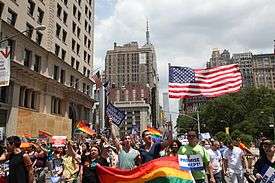

The annual New York City Pride parade traverses southward down Fifth Avenue and ends at Greenwich Village. The march passes by the site of the Stonewall Inn on Christopher Street, the location of the 1969 police raid which launched the modern LGBT rights movement.[51]
The march, the rally, PrideFest (the festival), and the Dance on the Pier are the main events of Pride Week in New York City LGBT Pride Week. Since 1984, Heritage of Pride (HOP) has been the producer and organizer of Pride Events in New York City.[52]
History of the New York City Pride parade
Early on the morning of Saturday, 28 June 1969, gay (LGBT) individuals rioted following a police raid on the Stonewall Inn, a gay bar at 53 Christopher Street, in the West Village of Lower Manhattan. This riot and further protests and rioting over the following nights were the watershed moment in modern LGBT Rights Movement and the impetus for organizing LGBT pride marches on a much larger public scale.
On November 2, 1969, Craig Rodwell, his partner Fred Sargeant, Ellen Broidy, and Linda Rhodes proposed the first pride march to be held in New York City by way of a resolution at the Eastern Regional Conference of Homophile Organizations (ERCHO) meeting in Philadelphia.[53]
That the Annual Reminder, in order to be more relevant, reach a greater number of people, and encompass the ideas and ideals of the larger struggle in which we are engaged-that of our fundamental human rights-be moved both in time and location.We propose that a demonstration be held annually on the last Saturday in June in New York City to commemorate the 1969 spontaneous demonstrations on Christopher Street and this demonstration be called CHRISTOPHER STREET LIBERATION DAY. No dress or age regulations shall be made for this demonstration.
We also propose that we contact Homophile organizations throughout the country and suggest that they hold parallel demonstrations on that day. We propose a nationwide show of support.[54][55][56][57]
All attendees to the ERCHO meeting in Philadelphia voted for the march except for Mattachine Society of New York, which abstained.[54] Members of the Gay Liberation Front (GLF) attended the meeting and were seated as guests of Rodwell's group, Homophile Youth Movement in Neighborhoods (HYMN).[58]
Meetings to organize the march began in early January at Rodwell's apartment in 350 Bleecker Street.[59] At first there was difficulty getting some of the major New York organizations like Gay Activists Alliance (GAA) to send representatives. Craig Rodwell and his partner Fred Sargeant, Ellen Broidy, Michael Brown, Marty Nixon, and Foster Gunnison of Mattachine made up the core group of the CSLD Umbrella Committee (CSLDUC). For initial funding, Gunnison served as treasurer and sought donations from the national homophile organizations and sponsors, while Sargeant solicited donations via the Oscar Wilde Memorial Bookshop customer mailing list and Nixon worked to gain financial support from GLF in his position as treasurer for that organization.[60][61] Other mainstays of the organizing committee were Judy Miller, Jack Waluska, Steve Gerrie and Brenda Howard of GLF.[62] Believing that more people would turn out for the march on a Sunday, and so as to mark the date of the start of the Stonewall uprising, the CSLDUC scheduled the date for the first march for Sunday, June 28, 1970.[63] With Dick Leitsch's replacement as president of Mattachine NY by "Michael Kotis" in April, 1970, opposition to the march by Mattachine ended.[64]
Brenda Howard is known as the "Mother of Pride", for her work in coordinating the march. Howard also originated the idea for a week-long series of events around Pride Day which became the genesis of the annual LGBT Pride celebrations that are now held around the world every June.[65][66] Additionally, Howard along with fellow LGBT Activists Robert A. Martin (aka Donny the Punk) and L. Craig Schoonmaker are credited with popularizing the word "Pride" to describe these festivities.[67] As LGBT rights activist Tom Limoncelli put it, "The next time someone asks you why LGBT Pride marches exist or why [LGBT] Pride Month is June tell them 'A bisexual woman named Brenda Howard thought it should be.'" [68]
There was little open animosity, and some bystanders applauded when a tall, pretty girl carrying a sign "I am a Lesbian" walked by. – The New York Times coverage of Gay Liberation Day, 1970[69]
Christopher Street Liberation Day on June 28, 1970 marked the first anniversary of the Stonewall riots with an assembly on Christopher Street and the first LGBT Pride march in U.S. history, covering the 51 blocks to Central Park. The march took less than half the scheduled time due to excitement, but also due to wariness about walking through the city with gay banners and signs. Although the parade permit was delivered only two hours before the start of the march, the marchers encountered little resistance from onlookers.[70] The New York Times reported (on the front page) that the marchers took up the entire street for about 15 city blocks.[69] Reporting by The Village Voice was positive, describing "the out-front resistance that grew out of the police raid on the Stonewall Inn one year ago".[71]
Media
LGBT publications include Gay City News, GO, and Next.[32]
Out FM is an LGBT talk radio show.
Former publications include Gaysweek, The New York Blade, and New York Native.
The film Paris is Burning documents the cultural contributions of gay, bisexual and trans New Yorkers mostly from Harlem ; especially those of color coming from mostly black or Latino backgrounds. Much of the documentary centers around drag culture. African American and Latino members of the LGBT community in the 80s invented dances such as vogueing and coined terms such as 'reading' and 'throwing shade.'
Education
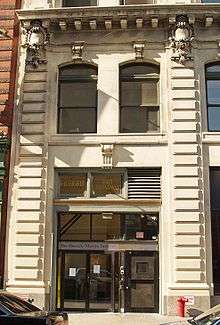
The New York City Department of Education operates Harvey Milk High School in Manhattan; it caters to but is not limited to LGBT students.
Religion
Congregation Beit Simchat Torah ("CBST") is a Jewish synagogue located in Manhattan. It was founded in 1973[72] and describes itself as the world's largest LGBT synagogue.[73] The Metropolitan Community Church of New York (MCCNY) in the Hell's Kitchen neighborhood of Midtown Manhattan is affiliated with the worldwide Metropolitan Community Church.
Recreation
Heritage of Pride or NYC Pride organizes LGBT community events such as the LGBT Pride March. The New York Lesbian, Gay, Bisexual, & Transgender Film Festival is held in the city. MIX NYC organizes other LGBT film festivals. The Fresh Fruit Festival exhibits works of LGBT artists.
Each month the New York Gallery Tours company offers an LGBT gallery tour.[49]
Historically, the St. Patrick's Day Parade has not allowed openly LGBT groups to participate. However, the organizers announced that in 2015 the first LGBT group will be permitted to have a float.[74]
New York City Black Pride is held annually in August.[75]
Escort raid
On August 25, 2015, the world's largest gay male escort website known as Rentboy headquartered in New York City was raided by the Justice Department. The website received over 500,000 unique visitors daily and had roughly 10,500 male escorts listed worldwide. The reason cited for the raid was that the website illegally operated as a prostitution service.[76][77]
Self-identifying LGBTQ New Yorkers
| |||||||||||||||||||
Broadway and stage acting
- David Burtka – Broadway and television actor, chef
- Quentin Crisp – late stage actor
- Neil Patrick Harris – Broadway and television actor, producer, singer, comedian, magician, and television host
Entrepreneurship and technology
Fashion
- Derek Lam – fashion designer
- Jason Wu – fashion designer
Film and television acting
- Laverne Cox – transgender actress[78]
- Kate McKinnon – comedian
- Cynthia Nixon – actress
Literature and photography
- Nahshon Dion Anderson Fuentes – actor and award winning writer
- Robert Mapplethorpe – late photographer
- Ocean Vuong – poet, essayist
Modeling
- Geena Rocero – supermodel and transgender activist
Media
- Frank Bruni – journalist, The New York Times
- Andy Cohen – television personality
- Anderson Cooper – journalist and television anchor, CNN
- Perez Hilton – blogger
- Rosie O'Donnell – television personality
- Shepard Smith – journalist and television anchor, Fox News Channel
Music
- Lady Gaga – singer and songwriter
Performance arts
- Shen Wei – choreographer, artist, and director[79]
Politics
- Carlos Menchaca – member of the New York City Council
- Christine Quinn – former Speaker of the New York City Council
Social activism
- John Chin – Gay Asian & Pacific Islander Men of New York
- Don Kao – Gay Asian & Pacific Islander Men of New York
- John Manzon – Gay Asian & Pacific Islander Men of New York
Sports
Visual arts
- Andy Warhol – late artist
See also
- Gay Asian & Pacific Islander Men of New York
- LGBT Americans
- LGBT rights in the United States
- New York City demographics
- Brooklyn Community Pride Center
- Pride Center of Staten Island
- LGBTQ Community Services Center of The Bronx, Incorporated (Bronx LGBTQ Center)
- Bronx Community Pride Center (Archive)
- Gay Men's Health Crisis (GMHC)
- Audre Lorde Project
References
- 1 2 3 4 Eli Rosenberg (June 24, 2016). "Stonewall Inn Named National Monument, a First for the Gay Rights Movement". The New York Times. Retrieved September 4, 2016.
- ↑ "Workforce Diversity The Stonewall Inn, National Historic Landmark National Register Number: 99000562". National Park Service, U.S. Department of the Interior. Retrieved September 4, 2016.
- ↑ Hayasaki, Erika (May 18, 2007). "A new generation in the West Village". Los Angeles Times. Retrieved September 4, 2016.
- ↑ Silverman, Brian. Frommer's New York City from $90 a Day (Volume 7 of Frommer's $ A Day). John Wiley & Sons, January 21, 2005. ISBN 0764588354, 9780764588358. p. 28.
- 1 2 Gary J. Gates (October 2006). "Same-sex Couples and the Gay, Lesbian, Bisexual Population: New Estimates from the American Community Survey" (PDF). The Williams Institute. The Williams Institute. Retrieved September 4, 2016.
- 1 2 3 Jennifer Fermino (March 7, 2016). "De Blasio: NYC toilets won't discriminate by gender identity". New York Daily News. Retrieved September 4, 2016.
- ↑ Kaiser, p. xiv.
- 1 2 Duberman, p. 183.
- ↑ Duberman, p. 185.
- ↑ Carter, p. 68.
- 1 2 Duberman, p. 181.
- ↑ Carter, p. 80.
- ↑ Duberman, p. 182.
- ↑ Carter, p. 71.
- 1 2 Duberman, p. 187.
- 1 2 Duberman, p. 189.
- ↑ Duberman, p. 188.
- ↑ Deitcher, p. 70.
- ↑ Carter p. 74.
- 1 2 Duberman, pp. 192–193.
- ↑ Carter, pp. 124–125.
- ↑ Eskow, Dennis (June 29, 1969). "4 Policemen Hurt in 'Village' Raid: Melee Near Sheridan Square Follows Action at Bar". The New York Times. p. 33. (subscription required)
- ↑ Associated Press (June 23, 2015). "NYC grants landmark status to gay rights movement building". North Jersey Media Group. Retrieved June 23, 2015.
- ↑ Carter, photo spread, p. 1.
- ↑ Carter, p. 137.
- ↑ Carter, pp. 96–103
- ↑ Carter, p. 142.
- ↑ Carter, p. 141.
- 1 2 Cristan Williams. ""So, what was Stonewall?"". The TransAdvocate. Retrieved October 26, 2016.
- ↑ "The Trans Community of Christopher Street". The New Yorker. August 1, 2016. Retrieved October 26, 2016.
- ↑ Lonely Planet New York City. Lonely Planet, September 1, 2012. ISBN 1743213468, 9781743213469. p. Google Books PT264 (Best LGBT section).
- 1 2 3 4 5 6 7 Rosenberg, Andrew and Martin Dunford. The Rough Guide to New York. Penguin Books, January 1, 2011. ISBN 184836590X, 9781848365902. p. 379.
- ↑ "NYC The Official Guide - LGBTQ". NYC & Company. Retrieved September 24, 2016.
- ↑ Edsall, pp. 253–254.
- ↑ Edsall, pp. 255–256.
- ↑ Adam, pp. 68–69.
- ↑ Carter, pp. 29–37.
- ↑ Carter, p. 46.
- ↑ Duberman, pp. 116–117.
- ↑ Carter, p. 48.
- ↑ Jackson, Sharyn (June 17, 2008). "Before Stonewall: Remembering that, before the riots, there was a Sip-In". The Village Voice. Retrieved on September 8, 2008.
- ↑ Rocco Parascandola and Jason Silverstein (September 18, 2016). "NYPD vetting Tumblr claiming to be Chelsea bomber 'manifesto'". New York Daily News. Retrieved September 18, 2016.
- ↑ Nicholas Confessore & Michael Barbaro (June 24, 2011). "New York Allows Same-Sex Marriage, Becoming Largest State to Pass Law". The New York Times. Retrieved September 4, 2016.
- ↑ Deborah Goldstein (July 27, 2010). "Where the Gays Are - Are Maplewood and South Orange the gay-family Mecca of the tri-state area? Maplewood, NJ". Maplewood Patch. Retrieved September 14, 2016.
- 1 2 Haider-Markel, Donald P. Gay and Lesbian Americans and Political Participation: A Reference Handbook (Political participation in America). ABC-CLIO, January 1, 2002. ISBN 1576072568, 9781576072561. p. 145.
- ↑ Haider-Markel, Donald P. Gay and Lesbian Americans and Political Participation: A Reference Handbook (Political participation in America). ABC-CLIO, January 1, 2002. ISBN 1576072568, 9781576072561. p. 144.
- ↑ Haider-Markel, Donald P. Gay and Lesbian Americans and Political Participation: A Reference Handbook (Political participation in America). ABC-CLIO, January 1, 2002. ISBN 1576072568, 9781576072561. p. 144-145.
- ↑ Scott M. Stringer, New York City Comptroller (June 2015). "LGBTQ Lesbian, Gay, Bisexual, Transgender & Queer Guide of Services and Resources" (PDF). City of New York. Retrieved September 16, 2016.
- 1 2 3 4 "NYC’s 5 Best LGBT Art Exhibits And Cultural Events" (Archive). CBS New York City. June 4, 2012. Retrieved on September 14, 2014.
- ↑ Cunningham, Jennifer H. "Disgraced ex-head of Bronx Pride Center, Lisa Winters, sentenced to 2-6 years in prison for grand larceny" (Archive). New York Daily News. Tuesday April 2, 2013. Retrieved on September 14, 2014.
- ↑ Stryker, Susan. "Christopher Street Gay Liberation Day: 1970". PlanetOut. Archived from the original on September 13, 2016. Retrieved September 13, 2016.
- ↑ "About Heritage Of Pride". Nyc Pride. Retrieved September 13, 2016.
- ↑ Sargeant, Fred. "1970: A First-Person Account of the First Gay Pride March." The Village Voice. June 22, 2010. retrieved January 3, 2011.
- 1 2 Carter, p. 230
- ↑ Marotta, pp. 164–165
- ↑ Teal, pp. 322–323
- ↑ Duberman, pp. 255, 262, 270–280
- ↑ Duberman, p. 227
- ↑ Nagourney, Adam. "For Gays, a Party In Search of a Purpose; At 30, Parade Has Gone Mainstream As Movement's Goals Have Drifte." New York Times. June 25, 2000. retrieved September 13, 2016.
- ↑ Carter, p. 247
- ↑ Teal, p. 323
- ↑ Duberman, p. 271
- ↑ Duberman, p. 272
- ↑ Duberman, p. 314 n93
- ↑ "Channel 13/WNET Out! 2007: Women In the Movement". Thirteen.org. Retrieved 2013-12-03.
- ↑ The Gay Pride Issue: Picking Apart The Origin of Pride Archived February 7, 2012, at the Wayback Machine.
- ↑ Dynes, Wayne R. Pride (trope), Homolexis
- ↑ http://web.archive.org/web/20060214163344/www.bisquish.com/squishive/2005/07/27/in-memoriam-brenda-howard-2/
- 1 2 Fosburgh, Lacey (June 29, 1970). "Thousands of Homosexuals Hold A Protest Rally in Central Park", The New York Times, p. 1.
- ↑ Clendinen, p. 62–64.
- ↑ LaFrank, Kathleen (ed.) (January 1999). "National Historic Landmark Nomination: Stonewall", U.S. Department of the Interior: National Park Service.
- ↑ "The LGBTQ Synagogue / About". Mission & Vision. Retrieved 14 October 2013.
- ↑ Lemberger, Michal (March 11, 2013). "Gay Synagogues' Uncertain Future: As mainstream acceptance grows—along with membership—gay congregations face unexpected questions". Tablet Magazine. Retrieved 14 October 2013.
- ↑ Sgueglia, Kristina and Ray Sanchez. "New York St. Patrick's Day parade to include first gay group" (Archive). CNN. September 3, 2014. Retrieved on September 14, 2014.
- ↑ http://www.nycblackpride.com/
- ↑ http://pix11.com/2015/08/25/rentboy-ceo-workers-arrested-in-raid-of-escort-service/
- ↑ http://thinkprogress.org/lgbt/2015/08/30/3696447/rentboy-raid-and-sex-trafficking/
- ↑ "Lady Gaga and other celebs react to New York explosion". Fox News Network. September 18, 2016. Retrieved September 18, 2016.
- ↑ "Gay Chinese Artist To Speak on Sept. 22 LGBT Gallery Tour – Nude Male Photos." Accessed November 6, 2016. http://nygallerytours.com/gay-chinese-artist-to-speak-on-sept-22-lgbt-gallery-tour-nude-self-portraits/] "Gay Chinese Artist To Speak on Sept. 22 LGBT Gallery Tour – Nude Male Photos." Accessed November 6, 2016. Check
|url=value (help). Missing or empty|title=(help)
Further reading
- Chauncey, George. 1994. Gay New York: gender, urban culture, and the makings of the gay male world, 1890-1940. New York: Basic Books.
- Kaiser, Charles. The Gay Metropolis: The Landmark History of Gay Life in America. Grove Press, 2007. ISBN 0802143172, 9780802143174.
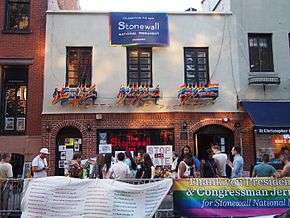
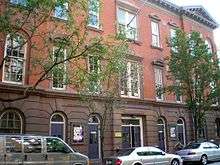
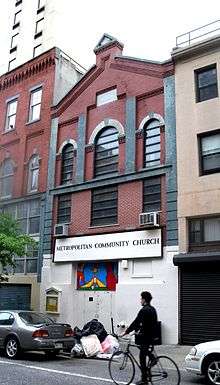
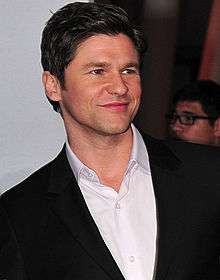

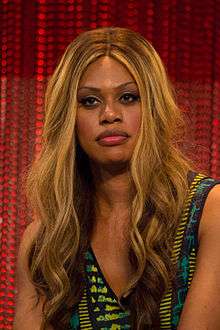

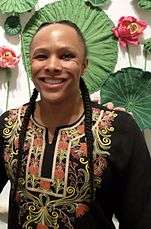
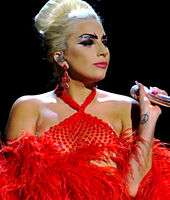



.jpg)
